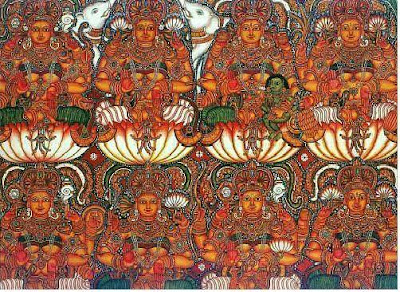The murals of Kerala are unique in their style, color and visual impact. They are considered among the finest in India due to unique depiction, variety of ornamentation, and richness in color. Kerala Murals often reflects the tradition, culture and religious beliefs and majority of this art can be found on the walls of ancient temples, churches and palaces. They are fresco and related to Dravidian art "kalamezhuth." What is believed to be the oldest murals of Kerala are found on the walls of rock temple Thirunanadikkara (now in Tamil Nadu) and are believed to be painted during the period between 9th to 12th century AD.
The period between 14th and 16th centuries is considered a classic era for Kerala murals. The murals of Mattanchery palace, Vadakkumnathan, Thrissur, Chemmanthitta and Kudamaloor still exhibits the classic examples of the creativity and skills of mural artists who lived during this period. Murals in their original beauty can still be enjoyed on the walls of the temples at Trikodithanam, Pundarikapuram, Ettumanur, Udayanapuram, Guruvayoor, Vaikom, Triprangode, Udayanapuram, Pundarikapuram and Sri Padmanabhaswamy temple at Thiruvananthapuram. And also in churches at Edappilly, Cheppad,Vechur and Mulanthuruthi. Murals at Krishnapuram palace and Padmanahapuram palace shows events of pre-historic times among many themes .
These glorious paintings are based on five base colors. They are red, yellow, black, green and white. The colors for the art are derived from natural substances and no synthetics are used. Minerals, juices, oils , herbs, roots etc form the base for colors. For example the colors like red and yellow are made from pigments of stones and green from the leaves and the blue from plants like indigo ferra. Black from carbon like soot of oil-lamps and white from lime stone. Even the brushes for painting are made from grass and hairs of animals such as goat or calf. Surface preparation for murals is a tedious job. The outline is sketched with charcoal or bamboo after the surface becomes completely dry.
Majority of Kerala murals are related to divine or heroic figures and so is considered a sacred art form. The murals of Kerala are a good example or living specimens of ancient Kerala paintings. See few of the murals that we managed to compile in the form of a gallery.
Kerala Murals

















































